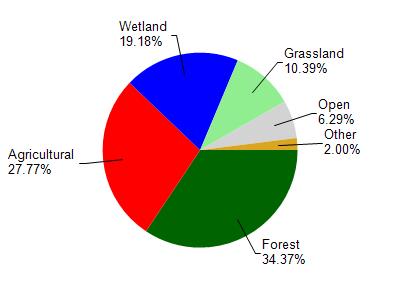Waushara
No
No
No
Fish and Aquatic Life
Overview
Auroraville Millpond, in the Pine and Willow Rivers Watershed, is a 180.12 acre lake that falls in Waushara County. This lake is managed for fishing and swimming and is currently not considered impaired.
Date 2011
Author Aquatic Biologist
Historical Description
Source: 1970, Surface Water Resources of Waushara County Auroraville Pond T-18-N, R-12, 13-E, Sections 1, 6, 7, 12 Surface Acres = 208.6; S.D.F. = 2.91; Maximum Depth = 6 feet.
This pond is an impoundment on Willow Creek in the east central portion of the county. The flowage, created by the 7-foot high dam at Auroraville, is the third largest body of water in the county. The dam was constructed to provide a source of water power for milling. The drainage basin of this impoundment encompasses nearly 80 square miles. The upper portions of the inlet stream are classified as Class I and II trout waters, while the outlet stream is recognized as a warm water stream. The pond is very shallow, with an average depth of 3.5 feet. Muck is the primary bottom type. Sand and rubble are also present. The immediate shoreline of this impoundment is predominantly marsh. Nearly 700 acres of adjoining wetlands border Auroraville Pond. Major fish species include northern pike and largemouth bass, while bluegills, perch, sunfish and bullheads are the principal panfish species present. Spawning habitat and general conditions for panfish, bass and northern pike are rated as good. Even though the pond experiences an occasional partial winterkill, the fish population recovers well enough to provide fishing. The presence of carp and suckers in the pond may reach sufficient numbers to displace the game fish populations in the near future. Should the rough fish gain such proportions, chemical treatment of the pond may be necessary to rehabilitate the fishery. Shallow water and dense aquatic vegetation limit boating and swimming values of this impoundment. Weeds also affect fishability during summer months. Access is available from Highway 49, and navigable water access by way of the inlet. There are three dwellings on the shoreline. One boat livery is in operation at Auroraville.
Date 1970
Author Surface Water Inventory Of Wisconsin
Condition
Wisconsin has over 84,000 miles of streams, 15,000 lakes and milllions of acres of wetlands. Assessing the condition of this vast amount of water is challenging. The state's water monitoring program uses a media-based, cross-program approach to analyze water condition. An updated monitoring strategy (2015-2020) is now available. Compliance with Clean Water Act fishable, swimmable standards are located in the Executive Summary of Water Condition in 2018. See also the 'monitoring and projects' tab.
Reports
Management Goals
Wisconsin's Water Quality Standards provide qualitative and quantitative goals for waters that are protective of Fishable, Swimmable conditions [Learn more]. Waters that do not meet water quality standards are considered impaired and restoration actions are planned and carried out until the water is once again fishable and swimmable
Management goals can include creation or implementation of a Total Maximum Daily Load analysis, a Nine Key Element Plan, or other restoration work, education and outreach and more. If specific recommendations exist for this water, they will be displayed below online.
Monitoring
Monitoring the condition of a river, stream, or lake includes gathering physical, chemical, biological, and habitat data. Comprehensive studies often gather all these parameters in great detail, while lighter assessment events will involve sampling physical, chemical and biological data such as macroinvertebrates. Aquatic macroinvertebrates and fish communities integrate watershed or catchment condition, providing great insight into overall ecosystem health. Chemical and habitat parameters tell researchers more about human induced problems including contaminated runoff, point source dischargers, or habitat issues that foster or limit the potential of aquatic communities to thrive in a given area. Wisconsin's Water Monitoring Strategy was recenty updated.
Grants and Management Projects
| Project Name (Click for Details) | Year Started |
|---|
|
|
Monitoring Projects
| WBIC | Official Waterbody Name | Station ID | Station Name | Earliest Fieldwork Date | Latest Fieldwork Date | View Station | View Data |
|---|
| 244800 | Auroraville Millpond | 10019336 | Mill Pond - Auroraville Mill Pond -- Access | 7/14/2009 | 12/20/2010 | Map | Data |
| 244800 | Auroraville Millpond | 10007449 | Auroraville Millpond | 7/27/1999 | 7/10/2013 | Map | Data |
| 244800 | Auroraville Millpond | 704001 | Auroraville Lake - Deep Hole | 8/14/1979 | 8/14/1979 | Map | Data |
|

Watershed Characteristics
Auroraville Millpond is located in the Pine and Willow Rivers watershed which is 302.08 mi². Land use in the watershed is primarily forest (34.40%), agricultural (27.80%) and a mix of wetland (19.20%) and other uses (18.70%). This watershed has 377.48 stream miles, 11,273.01 lake acres and 33,136.61 wetland acres.
Nonpoint Source Characteristics
This watershed is ranked High for runoff impacts on streams, Not Ranked for runoff impacts on lakes and High for runoff impacts on groundwater and therefore has an overall rank of High. This value can be used in ranking the watershed or individual waterbodies for grant funding under state and county programs.However, all waters are affected by diffuse pollutant sources regardless of initial water quality. Applications for specific runoff projects under state or county grant programs may be pursued. For more information, go to surface water program grants.